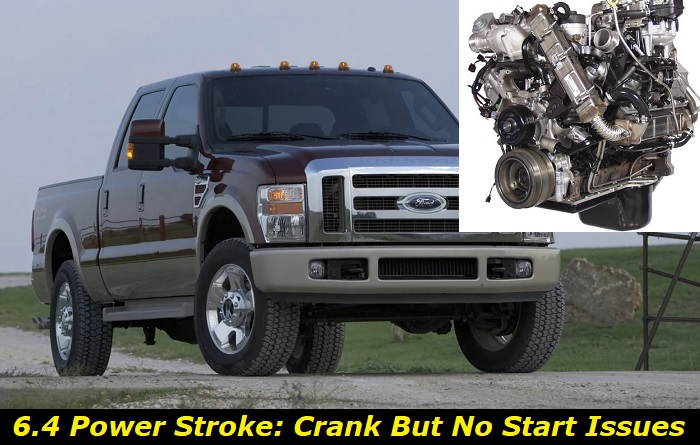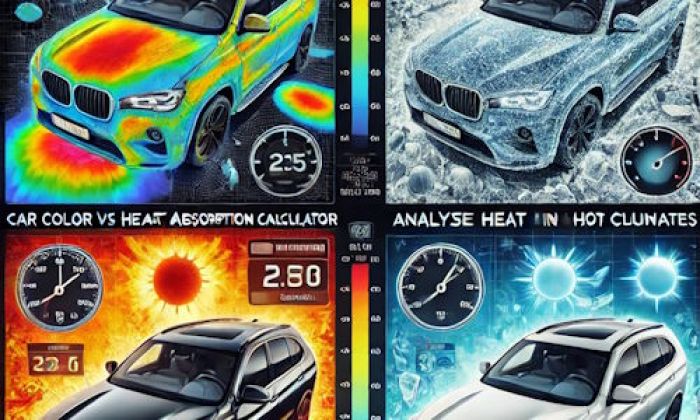The 6.4L V8 Powerstroke engine became part of Ford's Super Duty diesel truck lineup in 2008 when it was outsourced to International Navistar. Powerstroke is the brand name for a family of diesel engines used in Ford trucks. This powerful engine was the first to use a Diesel Particulate Filter (DPF) to lessen exhaust particulate emissions as a response to stricter emission regulations during that period.
Key features and my opinion about the engine
- Production years:2008-2010
- Average lifespan of 6.4 Power Stroke:230,000-250,000 miles
- Fuel supply type:Common Rail
- Power range:350 hp
- Fuel efficiency:bad
- Engine block material:cast-iron
- Engine reliability score:low
- The most common problems:oil consumption, turbo problems, EGR problems, DPF issues, high cost of maintenance, poor fuel economy.

Engine power
The engine in these trucks is powerful, with 350 horsepower and 650 lb/ft of torque. When properly equipped, they can tow very heavy loads. The engine has a twin turbocharger setup as standard. It has a single cam in the block and an OHV pushrod valvetrain.
The rocker arms operate the valves and each of them simultaneously opens and closes two valves. The 6.4L has impressive spool times and is a lot of fun to drive even without any tuning or modifications. The stock turbocharger configuration can generate up to 40 psi of boost!
Transmission
The 6.4L Power Stroke engine was available with a 6-speed manual or a 5-speed TorqShift automatic transmission. Both are well-known for their durability, with the automatic outperforming the manual mode in terms of power.
The TorqShift transmission was designed to handle the high engine output of the Ford Super Duty. It has six gears that are evenly distributed to provide low-end muscle and high-end efficiency. You'll feel a level of control that is rare in the trucking world. It is built to exacting Built Ford Tough standards to ensure dependable performance including hours of torture testing at maximum engine torque as well as testing in temperatures below freezing.
Towing capacity
When it comes to hauling heavy loads or towing trailers, the Ford 6.4L Powerstroke diesel engine is a great choice, especially for those who want a little more power and torque than a gasoline engine can provide. The 6.4L Powerstroke diesel engine in the 2010 Ford F-250 can easily tow 16,000 pounds.
The Powerstroke engine is designed to give your truck the power it needs to tow large loads. The towing capacity is enhanced by the truck's sturdy frame and suspension, making it perfect for hauling a boat, camper, or trailer full of equipment. With plenty of torque and power on tap, the 6.4L engine will make light work of any task you throw at it.
Durability
The Power Stroke engine is designed for durability and heavy-duty use. It has a cast-iron block and cylinder head. The structure is made of high-quality materials for strength and durability. This engine also has a forged-steel crankshaft and connecting rods for added strength. Ultimately, it is built for decent longevity and can withstand the rigors of heavy-duty use.
Other specs
- Production: 2008 to 2010
- Valvetrain: OHV, four valves per cylinder, single cam
- Bore: 3.87 inches
- Injection System: High-pressure common-rail, direct injection
- Stroke: 4.13 inches
- Displacement: 390 ci
- Injection Pump: Siemens K16 VDO high-pressure fuel pump
- Compression Ratio: 17.5:1
- Turbocharger: BorgWarner series sequential (compound) turbos
- Block: Cast-Iron
- Rods: Powdered-metal
- Emissions: Exhaust gas recirculation (EGR), diesel oxidation catalyst (DOC), diesel particulate filter (DPF)
- Pistons: Cast-Aluminum
- Heads: Cast-iron with four 16mm head bolts per cylinder (with sharing)
- Intercooler: Air-to-Air
Crank and no start: Possible Issues and Fixes
Starting the engine is one of the most important steps in making sure any vehicle is operational. The 6.4L Powerstroke diesel engine is no exception to hot or cold starting issues. While it can be frustrating, there are a few things you can do to try to fix the problem.
1) Fuel supply issues
If your diesel truck engine is not starting, it may be due to fuel supply issues. A diesel engine needs a higher volume of fuel to start than a gasoline engine, so if there is not enough fuel reaching the engine, it will not start. There are a few things that could be causing this problem:
Solution: Check the fuel tank, fuel filter, fuel injectors, and fuel pump to see if any problems need to be fixed.
- Make sure to check the fuel gauge to see how much fuel is in the tank. If it's low, fill it up and try starting the engine again.
- The fuel filter might be clogged. A clogged fuel filter can prevent enough fuel from reaching the engine. Try replacing the fuel filter to see if that fixes the problem.
- The fuel injectors might be dirty. Dirty injectors can also prevent enough fuel from reaching the engine. Clean or replace the injectors to see if that solves the problem.
- There could be a problem with the fuel pump. If the pump is not working properly, it will not be able to supply enough fuel to the engine. Check the fuel pump to see if it needs to be replaced.
- There could be a leak in the fuel line. A fuel leak can cause the engine to not start because there is not enough fuel reaching it. Check the fuel lines for any leaks and repair them if necessary.
2) Battery issues
If your 6.4L Powerstroke engine won't start, it could be because of battery issues. The most common reason is that the battery is not providing enough power to the starter. This can be caused by several things, including a weak battery or a loose connection between the battery and the starter.
Solution: If the battery is more than three years old, it may need to be replaced or the battery terminals are corroded, they may need to be cleaned. Also check if the battery cables are loose, they may need to be tightened. Finally, If the battery is dead, you may need to jump-start the engine.
3) Starter motor issues
The starter motor is responsible for turning over the engine, and if it is not working properly. After checking the battery and you find them to be working fine but the engine is still not starting, it is likely due to starter motor issues.
Solution: Then you will need to troubleshoot the starter motor itself. This can be done by testing the solenoid and brushes. If the starter motor is bad, it will need to be replaced.
4) Glow plug issues
When it's cold outside, glow plugs are a necessity for starting diesel engines. Glow plugs warm up the combustion chamber to help atomize diesel fuel, which needs assistance during combustion. In the winter, starting your engine can be very challenging if any of your glow plugs are defective.
Solution: The first thing you should do is check the plugs themselves. You can do this by removing them and testing them with a multimeter. If they are not working, they will need to be replaced. If the glow plugs seem to be working fine, the next step is to check the electric system around the glow plug controller. Make sure they are tightly connected.
5) Air intake issues
Proper air intake is very important for the engine to work. The engine needs a certain amount of air to run, and if there's not enough air getting into the engine, it won't start. There are a few reasons why there might not be enough air getting into the engine. One possibility is that the air filter is dirty and needs to be replaced. Another possibility is that the air intake hose is cracked or damaged and needs to be repaired or replaced.
Solution: Check the air intake system to make sure there's no blockage or damage.
6) Injector issues
One of the most crucial devices for making sure your engine starts reliably in the winter is the cold start injector. The hydraulically actuated, electronically controlled unit injector (HEUI) system on the Ford Powerstroke engine is frequently difficult to maintain. For cold starts, the quality of your engine oil is crucial because the HEUI system depends on it for the fuel injector.
Cold Start Solution: A cold start injector is typically repaired by replacing the component. The cold start valves must be found, the electrical connector must be unplugged, the fuel line must be cut off, the new valve must be loosened, the valve must be replaced, and the fuel line must be reconnected.
Hot Start Solution: Several things could be causing a hot start issue in your 6.4 Powerstroke, they can either be because of a leak in the fuel system or poor fuel quality. Replace fuel filters and treat fuel with a solution recommended by your trusted mechanic.
Final words
For a brief period, Ford trucks used the 6.4L Powerstroke diesel engine. This was at a time when stricter emission regulations were being implemented. The truck world was surprised by these powerful and heavy-duty engines since these models were also cleaner and quieter than their predecessors, while also having a more powerful engine.
Although it has some flaws, the Ford 6.4L Powerstroke still belongs in the ranks of decent trucks that can get the heavy-duty job done.
About the authors
The CarAraC research team is composed of seasoned auto mechanics and automotive industry professionals, including individuals with advanced degrees and certifications in their field. Our team members boast prestigious credentials, reflecting their extensive knowledge and skills. These qualifications include: IMI: Institute of the Motor Industry, ASE-Certified Master Automobile Technicians; Coventry University, Graduate of MA in Automotive Journalism; Politecnico di Torino, Italy, MS Automotive Engineering; Ss. Cyril and Methodius University in Skopje, Mechanical University in Skopje; TOC Automotive College; DHA Suffa University, Department of Mechanical Engineering






Add comment